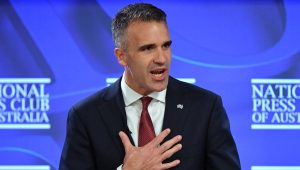Has red tape cost South Australia 80 years of prosperity? > Check the facts
Who: “We lost 80 years of prosperity for a whole state because of seven years of approvals which were unfinished.” Andrew Robb, South Australia Minister for Trade and Investment, referring to the failure of BHP Billiton’s Olympic Dam expansion project in South Australia.
The claim: That approval processes caused the failure of BHP Billiton’s expansion of the Olympic Dam copper, uranium, gold and silver mine. That this project is vital to the prosperity of South Australia for the next 80 years.
The facts: BHP Billiton released its Environmental Impact Statement (EIS) for the Olympic Dam expansion in mid 2009 and after a supplementary EIS process the project received federal and state government approval in October 2011. In August 2012, the company shelved the approved project stating that market conditions, including subdued commodity prices and higher capital costs, had led to the decision:
“As we finalised all the details of the project in the context of current market conditions, our strategy and capital management priorities, it became clear that the right decision for the Company and its shareholders was to continue studies to develop a less capital intensive option to replace the underground mine at Olympic Dam.”
The company’s announcement makes no mention of approval delays as contributing to its decision, and “commended” the South Australian government.
The finding: Based on the company’s statements and media reports, the decision not to proceed with the project is not related to assessment processes as Mr Robb stated.
Discussion of evidence: Furthermore, Mr Robb’s impressions of the project in terms of its life and importance to the South Australian economy are also incorrect. The estimated mine life of the project is 40 years (see figure 3.9), it is unclear where Mr Robb’s estimate of 80 years comes from.
According to the EIS economics chapter, the project would contribute between $650 million and $6,900 million to South Australia’s Gross State Product (GSP) per year over the project’s first 30 years. Annual GSP in South Australia in 2011-2012 was $91,900 million. Average government revenues from the project to the state government are estimated to vary between $30 million and $520 million. In 2012-13 total government revenue was $1,500 million (see table 3.4). While the project would have made a contribution to the state’s output and government revenue, the prosperity of the people of South Australia is not likely to be substantially affected.
Between the Lines Newsletter
The biggest stories and the best analysis from the team at the Australia Institute, delivered to your inbox every fortnight.
You might also like
Left behind: South Australian public servants go backwards while the SA economy surges forward
South Australian public servants are 10% worse off now than they were five years ago, despite the state’s booming economy, according to new research by The Australia Institute.
What to expect on Election Day: history could be made, or we’re in for a long wait
As Americans vote in one of the most important presidential elections in generations, the country teeters on a knife edge. In the battleground states that will likely decide the result, the polling margins between Democrat Kamala Harris and Republican Donald Trump are razor thin.
South Australian electoral experiment deserves much closer scrutiny
With the South Australian House of Assembly considering dramatic changes to electoral law this week, The Australia Institute warns the process has been rushed and the legislation is compromised and unfair.


